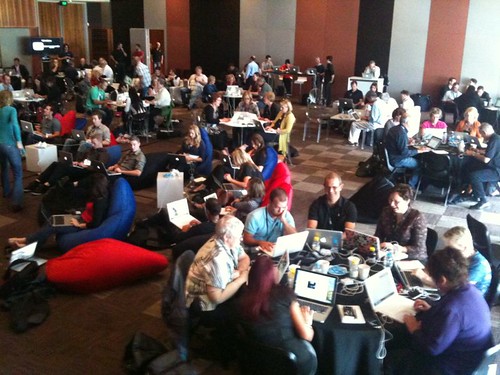<understatement>I’ve been to a lot of conferences lately.</understatement>
The Champion Schools Conference in Wellington. ACEC in Mebourne. ITSC on the Gold Coast, then Adelaide, Sydney and Perth. They’ve all been very good and I’ve gotten something from all of them. They’ve all had slightly different angles and focuses, but it’s pretty clear that any worthwhile education-based conference these days tends to have the same consistent underlying message, one that most active members of the edtech community would have heard many times before… The world is changing, technology is helping drive that change, and schools need to move with that change if they are to remain relevant. That’s it in a nutshell. Of course, there are many much deeper conversations we need to keep having about the how, why, what, when and where of enabling these changes, and we need to keep pushing the message out to those teachers still unaware that these fundamental changes are shifting the ground beneath them.
I have a friend who used to work in the newsroom of a major television station. He once explained to me how, when a really big story broke, the newsroom’s job would be to tell that story over and over for the next few hours or even days. There would be the initial newsbreak, but then it would get spot coverage each hour, followed by continuous newsbreaks, a piece in the nightly news and then again in the late news, and so on. I once asked my friend why they saturated the media so much with news stories like that, and questioned whether it was overkill to keep reporting the story ad nauseum, to which his reply was “In a newsroom, we know that when we are thoroughly sick of hearing about a particular story, the general public is only just starting to understand what it’s all about.”
So, as much as I might keep hearing the same fundamental messages being relayed over and over at most of these conferences, it’s still true that there are lots of regular classroom teachers for whom many of these ideas are quite a revelation. The impact that digital technologies are having on our students, the need for a shift in the way we approach the design of learning tasks, the imperative for offering students choices and options as a means of maintaining engagement, and the general idea of teaching less so students can learn more… these are still totally new ideas for many educators.
While conferences might try to promote these ideas through the lens of educational technologies, the true importance of them is firmly rooted in pedagogy, not technology. While we talk a lot about how digital technologies are a useful tool for “21st century learning”, technology just happens to be a powerful enabler for these new pedagogical approaches. It may appear that we edtech types are constantly promoting the use of technology just because we happen to like technology, but it runs deeper than that. We promote the importance of technology because, if you have been embedding technology into your teaching for any length of time now, you’ve seen first hand just how effectively it can start to shift the way your classroom operates. You know it can increase engagement, raise the quality of the work, make the learning more authentic, more on-demand, because you’ve seen it. And while you might value the role of technology in enabling all these things, you also realise that it’s not really about the technology, but rather the learning.
One of the great frustrations for those of us “in the echo chamber” of edtech is that, while we can see the value that technology brings to our work with kids in classrooms, we sometimes appear to just be enthusiastic about technology for the sake of it. We implore our colleagues to try blogging with their students, or to give wikis a go, or consider allowing that boring essay task to be submitted as a podcast. And so often our enthusiasm for the power of these tools is all too easily perceived as technological zealotry, and the promotion of technology as a solution to every problem.
So, back to these conferences, and their intended purpose of shifting the participants understanding of 21st century education. It’s been really interesting to see the lights come on with many of the participants. It’s really gratifying to hear teachers say things like “I’ve never even considered many of these ideas before, but I’m going to take them back to classroom and give them a serious go”. For at least some of the people I’ve been meeting at these conferences over the last few months, they left excited about the possibilities and felt inspired to learn more and to apply their newly discovered ideas back in the classroom.
One of the ironies of most conferences is that they are so often based on the idea of having someone stand on the stage or at the front of a workshop and simply talk at the participants… ironic because that’s usually the very model of teaching that the speakers are saying we shouldn’t be perpetuating. (For the record, I stand accused… as someone who has delivered some of these talks, I’m as guilty as the next person) In slight defense of this sage-on-the-stage model though, in some circumstances it’s still the most efficient way to share ideas with a large group. It’s just ironic that we still design conferences to help us learn what a 21st century classroom should look like by doing exactly the opposite.
 It’s not all like that though. One of the standout conferences I’ve attended is the Innovative Technology in Schools Conference run by Apple. While it still has some elements of people standing in front of the whole group and talking at them, it also has a significant “unconference” component, where teachers work in small organic groups on passion projects that deeply engage them as learners. It’s been great to see a conference attempt to model itself on the principles of open discussion; of offering choices, options and highly personalised learning pathways; of forming groups based on the interests of the participants; of giving the necessary time to allow participants to create and change. And of course, of enabling all of this with the rich use of technology. In short, of treating the conference participants as actual 21st century learners rather than just attendees. The ITSC event stands out to me because it tries to actually BE the way it claims education should be, and in doing so it offers the participants a chance to actually “walk the walk”, rather than just “talk the talk”. Quite a few participants remarked to me that the penny finally dropped about the way education could be different because of the way the ITSC conference itself modeled how that change might actually look.
It’s not all like that though. One of the standout conferences I’ve attended is the Innovative Technology in Schools Conference run by Apple. While it still has some elements of people standing in front of the whole group and talking at them, it also has a significant “unconference” component, where teachers work in small organic groups on passion projects that deeply engage them as learners. It’s been great to see a conference attempt to model itself on the principles of open discussion; of offering choices, options and highly personalised learning pathways; of forming groups based on the interests of the participants; of giving the necessary time to allow participants to create and change. And of course, of enabling all of this with the rich use of technology. In short, of treating the conference participants as actual 21st century learners rather than just attendees. The ITSC event stands out to me because it tries to actually BE the way it claims education should be, and in doing so it offers the participants a chance to actually “walk the walk”, rather than just “talk the talk”. Quite a few participants remarked to me that the penny finally dropped about the way education could be different because of the way the ITSC conference itself modeled how that change might actually look.
There was also a real focus on the creation of an appropriate learning space for participants. Rather than the typical conference situation of having rows of chairs all facing the front, ITSC had a range of flexible seating and working arrangements, with lots of round tables, leather couches and beanbags. It had large plasma TV screens around the room where groups could gather and share. It had powerboards on every table, reliable open wifi, and a wiki server for participants to create collaborative digital workspaces on demand. These are the sorts of things that we know 21st century classrooms should look like, and can really help create an environment where the learning really hums along.
Importantly, participants were also asked to actually make something during this conference that they could both share with the group and also take away with them. Even more importantly, they chose what they made based on their unique interests and what would be useful to them. They chose who they teamed up and worked with. They decided what they needed to learn to complete their task and they learned it on the fly. They used technology in authentic ways to enable the process. It was genuine 21st century learning in action, and it was quite a powerful conference experience.
There are lessons in the ITSC events for all conference organisers.


 I wrote a blog post a little while back called
I wrote a blog post a little while back called